In the following discussion, we focus on the geochemical results from the main tributaries using data for seven elements: arsenic (As), cobalt (Co), copper (Cu), lead (Pb), strontium (Sr), vanadium (V), and zinc (Zn). The concentrations of cobalt, strontium, and vanadium do not vary significantly in the rocks underlying the Animas River watershed and reflect the rock geochemistry throughout the Animas River watershed, whereas the other four metals are largely derived from the various mineral deposits or alteration zones within the upper Animas River watershed upstream from Silverton. The enrichment of metals above crustal abundance values (CAV) is not only environmentally significant, but is used in assessing areas where mineral deposits might be present. In mineral exploration, areas characterized by metal concentrations three or more times above the CAV are routinely evaluated. For the seven elements discussed below, the CAV is: As, 1.8 ppm Co, 29 ppm Cu, 68 ppm Pb, 13 ppm Sr, 384 ppm V, 136 ppm and Zn, 76 ppm (Fortescue, 1992). Whereas we will use this enrichment concept in the discussion and evaluation of the metal distribution profiles, the CAV for an element in any given area should not be assumed to represent the background in that area. The geochemical background prior to mining must be determined by looking at premining sediments within the watershed.
These seven metals are present in several different mineralogical sites in the rocks and mineralized zones in the watershed. Metals sorbed onto the iron-hydroxides are weakly bound and are totally released by the 2M HCl-1%H2O2 digestion. Metals in the oxide and sulfide phases will be partially to completely digested by the 2M HCl-1%H2O2 leach procedure whereas metals in the silicate phases will not be removed 2M HCl-1%H2O2 digestion (Church and others, 1987). Minor amounts of metals reside in carbonate phases. Strontium, for example resides almost entirely in the silicate phase. Vanadium resides in the iron oxides hematite and magnetite in volcanic and plutonic rocks. Cobalt resides in both silicate phases and in pyrite. Copper, lead, and zinc reside in silicate phases, but are greatly enriched in mineral deposits as are arsenic and antimony. We will focus our geochemical discussion primarily on the geochemical results from the 2M HCl-1%H2O2 digestion procedure because this digestion removes all of the metals present in iron-hydroxide phases, including the colloidal precipitates. We refer to the metals removed by this leach as the "labile" metal component. Comparisons of the yields from the 2M HCl-1%H2O 2 digestion procedure relative to the data from the total digestion are very useful because significant portions of some metals in the stream sediments may be transported as detrital oxide and sulfide minerals. The primary sulfide minerals are: arsenopyrite (the primary source of arsenic), which is not digested by the 2M HCl-1%H2O2 leach procedure pyrite (the primary source of cobalt), which is not digested by the 2M HCl-1%H2O2 leach procedure chalcopyrite (the primary source of copper), which is not digested by the 2M HCl-1%H2O2 leach procedure galena (one primary source of lead), which is readily digested by the 2M HCl-1%H2O 2 leach procedure sphalerite (the primary source of zinc), which is partially digested by the 2M HCl-1%H2O2 leach procedure and tetrahedrite (a source of copper, lead, silver, arsenic, and antimony), which is not digested by the 2M HCl-1%H2O2 leach procedure (S.E. Church, unpubl. data). Thus, a comparison between the two data sets will provide some measure of the distribution of the metals present in the different mineralogical phases present in the bed sediments. In addition, vanadium in this environment is concentrated in magnetite and specular hematite, which are the "heavy" iron-oxide minerals. Some vanadium associated with the weathering of magnetite or hematite can be extracted by the 2M HCl-1%H2O2 digestion procedure, but vanadium data from the total digestion will be used as an indicator of placer accumulation of heavy minerals at the sites where bed-sediment samples were collected.
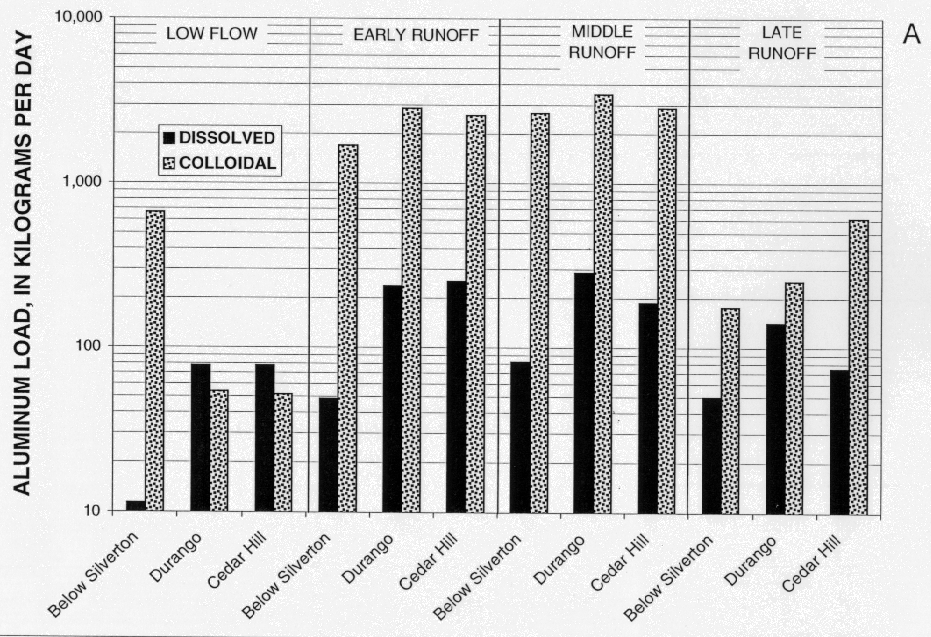
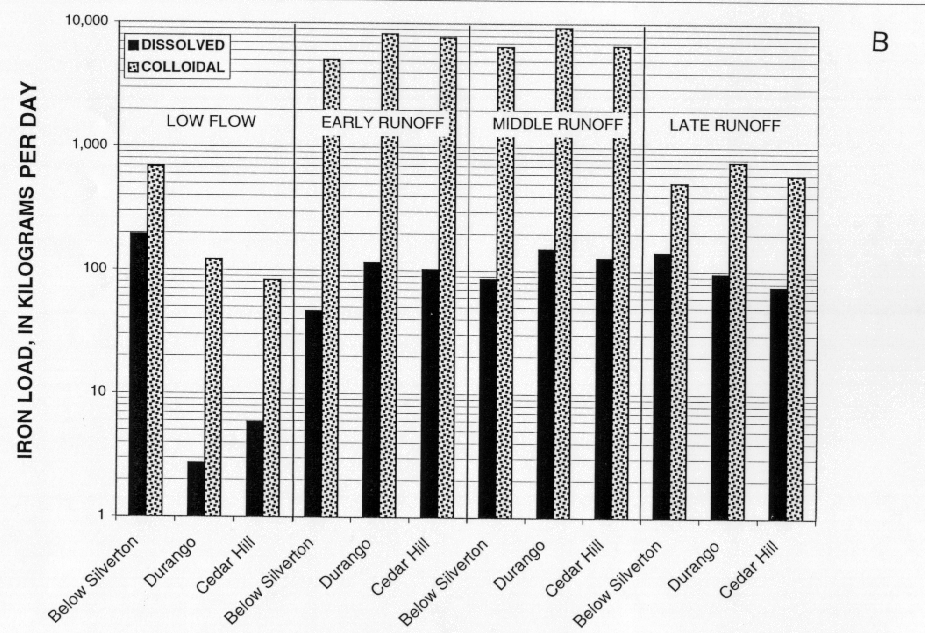
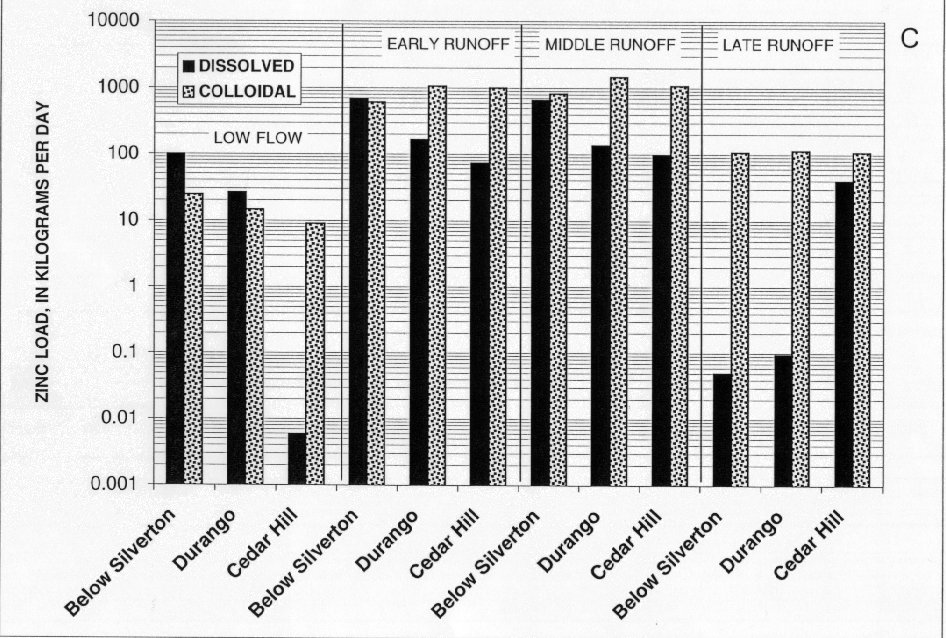
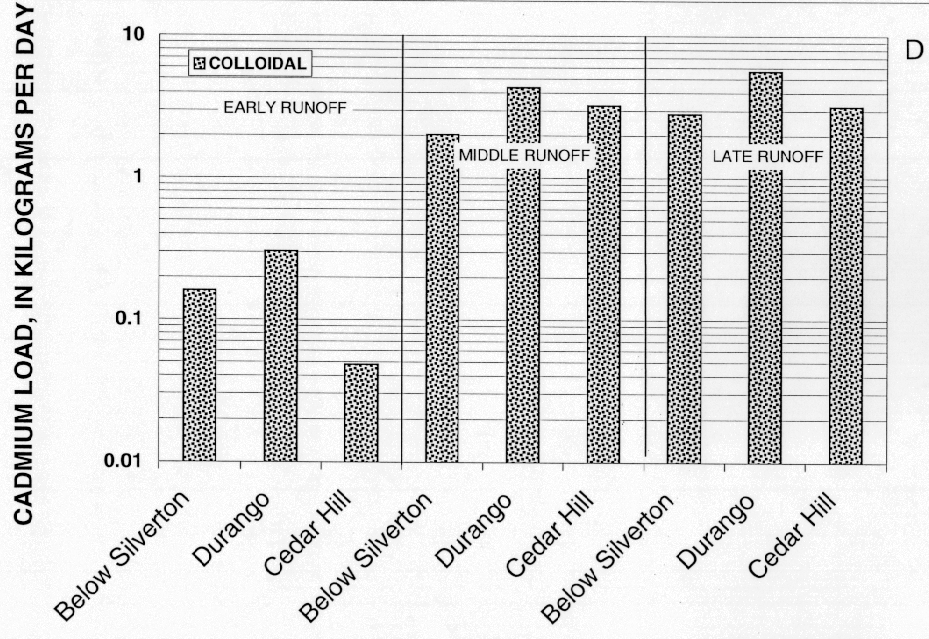
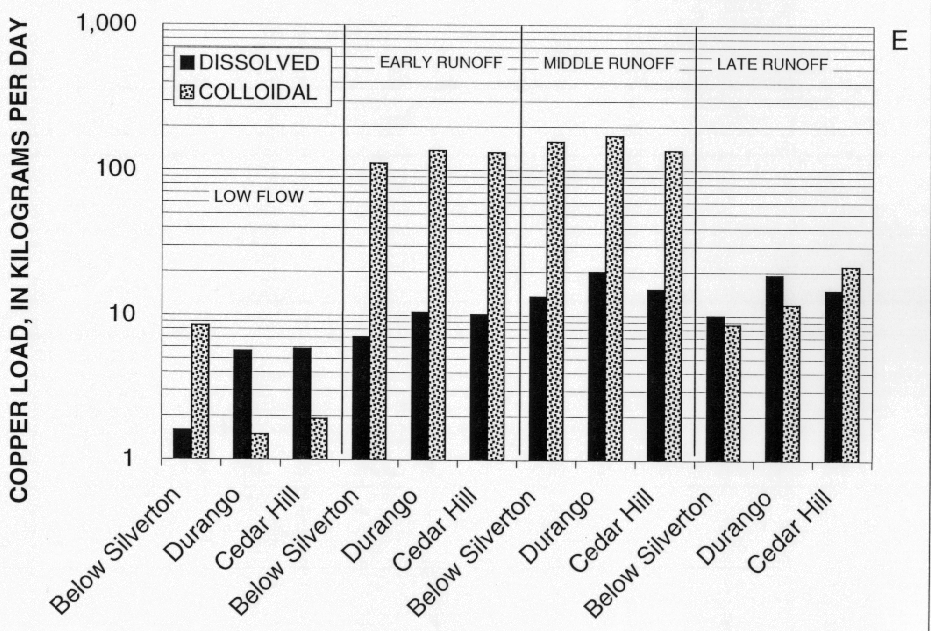
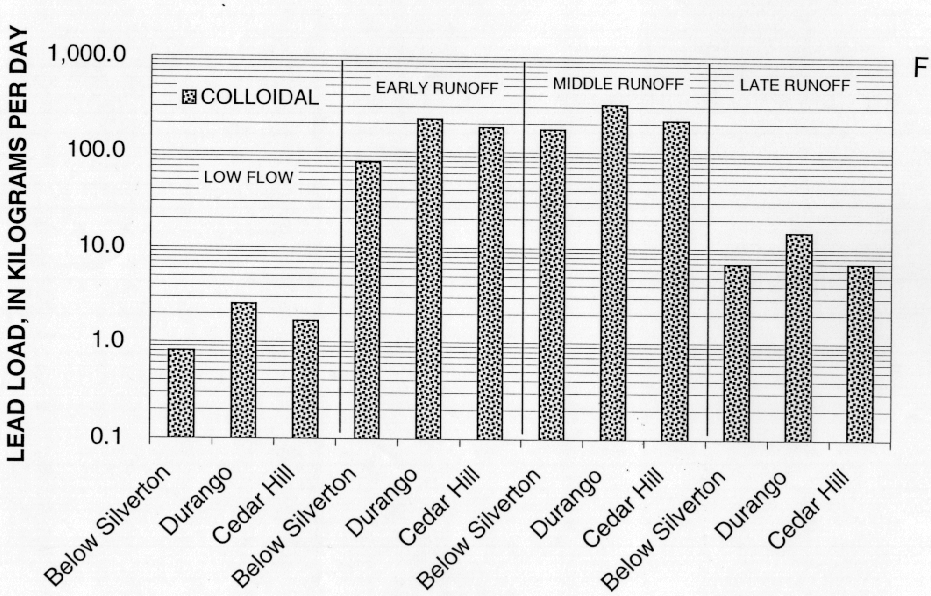
Placer accumulation occurs when the carrying capacity of the stream is high and the silicate detrital rock fragments are carried away while leaving the heavy-mineral phases behind. Most of the heavy-mineral phases have a density (specific gravity, sp. gr.) between 4.3 and 5.3 with the exception of galena (sp. gr. of 7.6) and gold (sp. gr. between 15-19) magnetite has a sp. gr. of 5.2. Thus, the monitoring of magnetite distribution is an excellent measure of the placering process. Since we are interested in the supply of metals to the streams rather than concentration of metals at a specific site in a stream reach by hydraulic processes, the use of the vanadium concentration provides a measure of the distribution of magnetite and shows the influence of the placering effect on the geochemical data set.
Bed-sediment samples collected from stream reaches for this study were analyzed for both the labile and total metal content. The geochemical data are presented in two formats, a map format and a profile format plotted against river distance, to aid in the interpretation of the metal dispersion or dilution patterns downstream. Geochemical data showing the dispersion of copper, lead, and zinc from the main tributaries and the Animas River are in a map format on figures 19-21. The metal concentrations for the intervals are the same as those used in the regional geochemical maps (see figs. 6-8) . A comparison of the reconnaissance geochemical map for copper (fig. 6) with the "ribbon" map showing the dispersion of copper (fig. 19) indicates that the concentration of copper in bed sediments exceeds 200 ppm for all of the Animas Canyon reach and for much of the lower Animas River south to Durango. In contrast, the copper concentration in stream sediments from tributaries throughout the watershed in areas underlain by either the Precambrian rocks that crop out in the Animas Canyon reach or the Paleozoic, Mesozoic, and Tertiary sedimentary rocks (fig. 3) that crop out in the lower Animas River generally have concentrations in the 40 ppm or less range (fig. 6). Clearly the source of copper in the bed sediments of the Animas River south of Silverton is from the Animas River watershed upstream from Silverton. The lead (fig. 7 and fig. 20) and the zinc "ribbon" maps (fig. 8 and fig. 21) show a pattern similar to that of copper, although the concentrations vary in magnitude.
For ease of presentation, the geochemical and lead-isotopic data in the profiles are plotted against downstream distances measured in kilometers (km) from the confluence of Mineral Creek with the Animas River below Silverton, which was arbitrarily assigned a value of 25 km. The reaches of the Animas River above and below Silverton are plotted separately. The sample site on the Animas River below the confluence (that is, site A-72 in the CDPHE data base at 26.25 km) is plotted as the most downstream point on all of the geochemical and lead-isotopic plots of data from the main tributaries (figs. 22-27) and the most upstream point on the plots of the data from the lower Animas River (figs. 28-29).
Sample types on these diagrams have been divided into five different categories: River (bed-sediment samples from the main tributaries or the Animas River), Tribs (bed-sediment samples from small tributary basins), Ovrbk seds (fine-grained sediment samples collected from bars or from the stream banks representing sediment transported during high water that has been subjected to wetting and drying and are a source of water-soluble salts), Other (largely samples of water-soluble efflorescent salts associated with the overbank sediments collected), and Mill tails (fine-grained deposits of mill tailings within the flood plain). Identification of specific sample types is in the data tables in the appendices and on individual figure captions. Data from both the total digestion data and the 2M HCl-1% H2O2 data are plotted these data will be referred to as the total metal and the labile metal concentrations.



We also analyzed the labile component for the lead-isotopic composition of the samples to "fingerprint" different sources of lead within the basin and to quantify the relative contributions of metals from the different mining districts to the total mass of metal in the bed sediments. Lead-isotopes can be used as a tracer of the fluvial processes because the unmineralized rocks and mineral deposits have differing lead-isotopic signatures. Three of the four isotopes of lead increase with time because they are the daughter products of the radioactive decay of uranium and thorium. For example, the amount of 206Pb has approximately doubled over the age of the earth. Relative to 204Pb, which has no radioactive parent, the 206Pb / 204Pb value has increased from about 9.35 at the time of the formation of our solar system to about 18.8 today. This change has resulted from the decay of 238U. Similar changes have occurred for the growth in 207Pb resulting from the decay of 235U, and 208Pb resulting from the decay of 232Th, although the change in the 207Pb / 204Pb is now insignificant for this particular application because of the short half-life of 235U. The "fingerprinting" of the different mineral deposit districts is possible because, at the time of the formation of the deposits, the lead contained in the deposits was separated from the radioactive parents and the composition of the lead-isotopic ratios was "frozen" into the deposits. In contrast, lead in the rocks within the Animas River watershed continues to change with time in direct proportion to the ratio of the parent isotopes to 204Pb. Lead is abundant in these mineral deposits. Lead from the deposits is readily removed by weathering and deposited in the bed sediments by sorbtion to or precipitation with the iron-hydroxide precipitates. This lead is readily removed by the 2M HCl-1%H2O2 leach procedure (100%). In contrast, only a small portion of the silicate-bound lead in unmineralized rock is released by weathering of the silicate minerals in the rocks that crop out in the basin. About 20-25 percent of the "silicate-bound rock lead" is extracted by the 2M HCI-1%H2O2 leach procedure. This "rock-lead" signature will be more radiogenic than the composition one would obtain from the total digestion as shown in earlier work (Gulson and others, 1992 Church and others, 1993). Therefore, the abundant lead from the mineral deposits, which is often present at hundreds to thousands of ppm, overwhelms the lead derived from weathering of silicate-bound lead from unmineralized rocks that crop out within the Animas River watershed and provides a sensitive tracer to measure the contribution of metals from mineralized areas within the basin.
Lead-isotopic data from galena in the deposits in the Silverton area are given in table 2. These limited data suggest that lead-isotopic composition of galena from the vein-type ore from the Eureka graben (fig. 4) varies over a small range (samples 1-3, table 2). The data from the two samples collected from the Eureka Mill and the Sunnyside Mill and from float in Cement Creek are of less value because we do not know which deposits they represent. The analysis from the Marcella Mine represents ore from a deposit associated with the Sultan Stock (fig. 4). The analysis of the lead from the white precipitate from the Paradise portal on the Gem claim on the Middle Fork of Mineral Creek indicates that this deposit differs from that of the vein-type ore lead from the Eureka graben. The composition of lead from the iron-hydroxide precipitate from the Koehler adit (appendix VII) also differs from the Eureka graben vein-type ore lead. The compositions of the galena samples are plotted on the lead-isotope diagrams when the mineralization type is present within the individual subbasin.